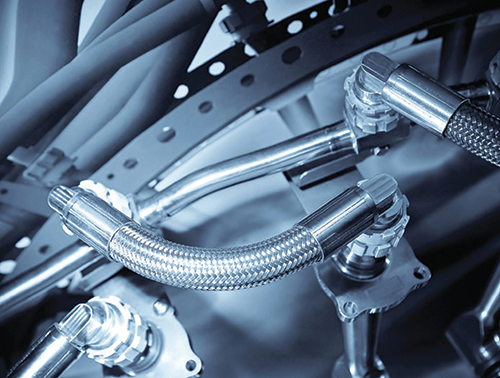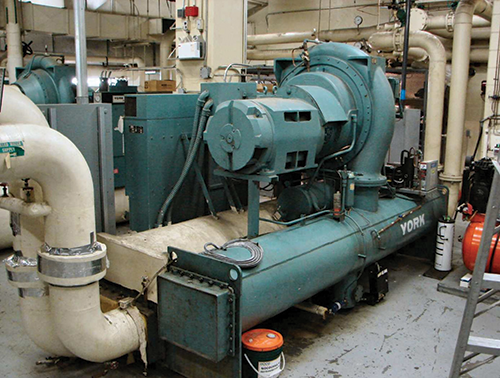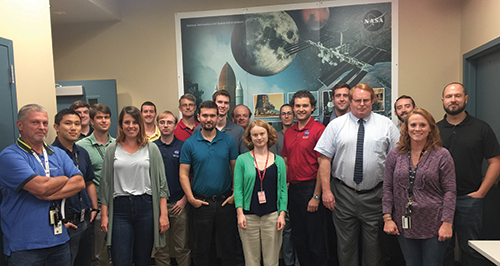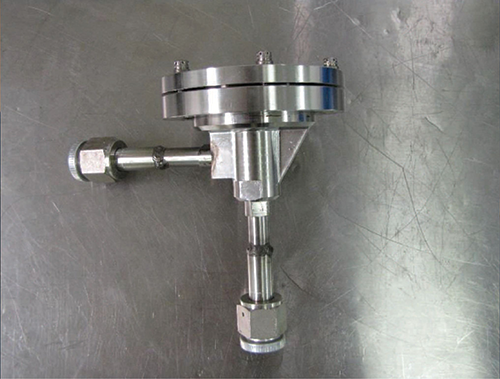EDITOR’S NOTE: Jim Richard is assistant branch chief for valves, actuators and ducts design and development at the Marshall Space Flight Center (MSFC) in Huntsville, AL which is part of the National Aeronautics and Space Administration (NASA). Richard, who grew up within sight of the huge Saturn rocket test stands located at MSFC, currently serves the Propulsion Systems Department as the lead technical mentor and expert in propulsion valves, lines and actuators for rockets and other spacecraft (See “A Life in Valves“). Because of his unique exposure to this equipment, as well as his long background in the field, VALVE Magazine asked him to talk about his experiences and the challenges today’s valves, actuators and controls face as they travel or work in outer space.
Jim Richard’ first memory involving valves occurred when he was 12 years old and his engineer dad, who was employed at NASA, talked about problems he was having with a valve at work. At the time, he didn’t understand the importance of what his dad was saying. That situation has changed tremendously and the equipment that faces space has become increasingly complex.
As far as his current job, “Our branch decided to count up how many valves [and related components] we are following: 2,500 on different rockets,” Richard said in a recent interview with VALVE Magazine. “Some of these are commercially available check valves — you can hold five of them in your hand. Some weigh hundreds of pounds. Some you can buy for reasonable amounts of dollars. Some cost multi-millions.”
All of these valves need to be built to precise fits and finishes and to stringent performance requirements because: “On a spacecraft, everything has got to work. If it breaks, you’re done,” he said.
Because of that reality, “We go through excruciating development programs, with qualification programs where we test to the extreme over every environment so all the valves will work on any mission.” This must be done for all 2,500 pieces of valve equipment.
NASA’s Valve Group
The valves, actuators and ducts design and development branch that Richard runs supports the Propulsion Systems Department at MSFC.
“We have responsibility for the design and development of rocket engine valves, actuators and lines for most NASA propulsion elements.”
As such, his group covers components flying on commercial rockets, has responsibility for several flight systems on the space station and payloads, is working with crewed vehicles (commercial as well as NASA) and is now working on human lunar landers.
“Our branch has grown from about 10 folks when I joined to 45 today,” he said. “We have a contractor force of more than 25 that supports us, and we keep growing. This is a very good time to work for NASA. I see a much more diverse set of goals and functions than those of the Space Race years.”
Richard’s group works in an oversight role, as NASA doesn’t build the valves itself. Instead, “Our prime contractors contract with valve manufacturers, and we ensure they build to our standards.”
Still, Richard also said he sees a need for internal development of valve expertise within NASA. His staff works to solve known problems such as leakage and chatter, developing and building perhaps two or three valve projects per year. By doing this, his group has the skills and knowledge to be smart buyers, he said.
Designing For Space
After safety and performance, lighter weight is the goal in spacecraft work, Richard explained. The MSFC website explains why: It costs $10,000 to put one pound into earth orbit.
“Weight is the enemy of our valves. If you have a steam plant and one valve weighs 10 pounds more than another, it doesn’t matter. We [NASA] shave off every bit of our valves to meet our specs,” he said.
This reality clashes with his past experiences with valves, Richard said. For example, at his first job working on Navy submarines, the most important trait for valves was reliability. “You can’t have your sub break in the middle of a battle,” he explained. “They [Naval engineers] couldn’t care less how much [a valve] weighed.” A heavier valve just meant less ballast was needed.”
Also, while terrestrial valves might allow a 200% performance margin, “Ours are more like a 20-30% margin,” Richard said.
To achieve those stringent requirements, Richard’s group conducts detailed flow, mechanical and thermal analyses.
“We nail down everything we can think of and quantify it and then test it and make sure it works,” he said. In this case, cost is not as much an issue as performance, weight and “surviving the ride,” he said. Because of this, a valve specification may run to 65 pages.
Surviving Harsh Conditions
Aerospace valves need to withstand a vast variety of environments. Temperatures range from the cryogenic — about -420°F (-251°C)—to over 3000°F (1649°C).
The vibration environments also can be extreme, sometimes up to 50g in a rocket. Rockets and their components have to withstand severe shock as well; when a pyrotechnic system fires to separate a stage, the action shakes the whole vehicle.
Another factor in space is that some valves may need to operate on a launch vehicle only as long as it takes to go into orbit, maybe eight minutes; others, such as those on the space station, need to last 25 years, he pointed out.
Because of all these challenges, materials are critical for valves. Richard said he could count on his fingers how many materials can be used.
Many of those materials have to deal with caustic fluids and other issues. The primary propellants [for space propulsion]—monomethylhydrazine and nitrogen tetroxide—can present many difficulties. “Everything else erodes, burns, swells, breaks or becomes embrittled,” he said.
Some materials that could do the job are not widely manufactured, which presents another problem. To obtain those materials could require buying a mill run of tons of material, which is not generally an option for a government agency on a budget.
The valve body needs to be as light and strong as possible. In general, carbon steel can’t be used, and the choice is limited to Inconel and other exotic materials. For cryogenic valves, high-strength 7000 or 2400 aluminum can do the job, Richard said.
Mysteries Solved
Richard gave some case studies of different valve problems solved at NASA that show just how challenging the field can be.
The first incident happened back in the days of the space shuttle, he said. There was a solenoid valve used to pressurize an external tank. This was a small valve, about the size of a human thumb. It ran at high pressure, 3000 psi, and high temperatures of about 600°F (316°C). The valve allowed flow into the tank to pressurize it, operating similar to a mushroom or poppet valve. One day “we discovered a piece missing from the edge of the valve,” Richard explained. The first issue was: what happened to break it? The second was: where did it go? It could have gone into the engine.
About 20 people investigated in various ways, including conducting stress analysis and computational fluid dynamics. Some time was required to pinpoint what the problem was, but once that was identified, the fix was straightforward. The valve in the high-flow position was inducing a vibration on the edge of the poppet, and it failed from fatigue. The question then became: why had this not occurred before since the same design had been in use for years? Finally, someone discovered the operations had been changed to keep the valve in a high-flow position for a longer time than in the past. Whoever made the change apparently thought this was acceptable; the result was a part vulnerable to breakage. Since the valves were already built, they now had to be inspected after every flight.
A second mystery involved a valve that had a detent mechanism. The valve would hold in one position until the actuator pushed the detent roller to another position where the detent would hold it. These valves were installed at six positions on each of four vehicles. But a roller was cracking and breaking, though only in a valve in one position on one vehicle. Also, the equipment did not break on every mission.
The staff came up with all kinds of theories. It turned out that one valve had a tolerance stack-up issue.
“We thought there was enough room for the detent to stroke, but it couldn’t fully stroke,” Richard explained. The actuator would push on the equipment and there was enough force to break the roller, which occurred only when the valve was cold and shrunken enough to catch the roller. On a hot day or if the valve wasn’t chilled, the roller had its full travel.
Once the tolerance stack-up was discovered, the parts were changed out for ones on the low side of tolerance, and the problem did not reoccur.
The Promise of 3D Printing
Richard said additive manufacturing offers opportunity for work in his field. He said he looks at an additive-manufactured part as if it were a high-quality casting part. However, 3D printing allows less spending on that part while providing a high-quality component, he said.
Also, additive manufacturing allows really unique geometry, he said. “In a valve, we can make a converging-diverging nozzle you couldn’t cast or machine.”
Overall, while additive manufacturing currently has limited application, the technology is definitely interesting to explore and offers possibilities. Bi- or multi-metallic 3D printing, for example, offers some promising applications. In such an approach, the additive manufacturing system builds a part in the usual way, but the process can change materials.
Also, hybrid additive/subtractive technology — where the same machine performs both additive and machining operations — also may show promise for the future, he said.
Looking Back
Richard said his career has been fulfilling and that work such as what his group does offers promise for up-and-coming engineering enthusiasts.
“I have been a mentor to interns, co-ops and new engineers,” he said. “I teach them to take ideas, try them out in the lab to see if they work.”
When they do work, “you can speak from a position of power,” he said. When they don’t work, “you learn to understand the limits.”
In his youth, Richard wondered how the valves his father talked about could be such a big deal to the overall process of space engineering. Today, one of his pet peeves is to hear: “It’s just a valve; how hard can that be? I can go to Lowe’s and buy a valve for $10. Why is this costing $500?” In other words, people greatly misunderstand how important valve design and construction is, he said. “It’s not ‘just a valve.’ It’s a complex machine,” he said.
Barbara Donohue is web editor of VALVE Magazine. Reach her at bdonohue@vma.org.
|
A LIFE IN VALVES As a youngster hearing about valves from his father, Richard recalls thinking, “How can valves be so complicated?” After that revelation, he started paying close attention to valves. He remembers being drawn to valves when visiting the rocket museum in Huntsville, AL. Later, as an engineering co-op student with the Navy, he gravitated to the mechanical division where valve work was a constant part of the job, he said. As such, he became even more fascinated. Yet, “It all started with those discussions with my dad.” But before valves became part of his daily job, Richard had another career. Like many teenagers, “I rebelled against the wishes of my parents and sought my own path,” he said. He wanted nothing to do with rocket engineering, so he went to trade school to train in welding. “This seemed to be a more creative, less stressful, and very rewarding type of work; I could see real progress every day.” Richard said that, although he was a good welder, he struggled to make a living, searching continually for work and often working long hours in uncomfortable conditions. Finally, “I called it quits and went off to engineering school at the University of Alabama in Tuscaloosa.” While studying mechanical engineering at school, he spent his co-op semesters working with the U.S. Navy in Charleston, SC, which resulted in a job after graduation in 1979. A few years later, he and his wife moved back to Huntsville, where he worked as a contractor at MSFC. “My work at the shipyard and for the contractor gave me hands-on hardware experience with various terrestrial mechanical systems, from submarines to cryogenic facilities,” Richard said. His fascination with valves returned, and he sought and was assigned jobs related to this equipment and the lines that connected it. “I became very familiar with valve design practices and worked more and more with NASA engineers solving their flight-related issues,” eventually becoming known in the aerospace valve field. In 1999, “I was lucky enough to be presented with a chance to become a NASA employee,” he said. Although his path to space and valves was not a direct one, Richard said that having worked hands-on as a welder gave him “huge respect for [those who] actually do the work we design for. It opened my eyes to what can realistically be made. When I’m designing, I think how will we make that part? Is it forged? Is it cast?” The challenge is as much how to make the equipment as what it will do, he said. “I think my background gave me a huge appreciation for the trades and the people who do this work. I say to my staff, ‘Have you talked to the machinists? Go talk to them. They have great skills and you should [listen to] them.’” |
RELATED CONTENT
-
Understanding and Selecting Valve Flanges, Pt. I: Design and Standards
Because flanges allow the assembly and maintenance of system components without the need for cutting and welding pipe, they play an important role in piping systems.
-
Standards for Actuator/Gearbox Flanges
“Many variations in valve and actuator dimensions and characteristics have come into play especially now that we have worldwide vendors,” said Paul Souza, training manager at AUMA Actuators in a presentation at the Valve Manufacturers Association Virtual Valve Forum in November 2020.
-
Fugitive Emissions Standards for Valves
API, ISO and TA Luft all have their own set of standards to control emissions. What are the differences and how do they compare?
















 Unloading large gate valve.jpg;maxWidth=214)